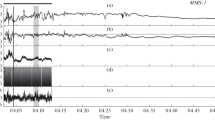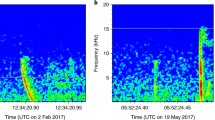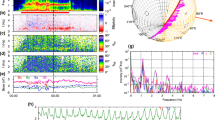Abstract
THE ‘whistling atmospheric’, or ‘whistler’, is the most common of the several types of quasi-musical atmospheric that are observed in the audio-frequency band of the radio spectrum. It takes the form of a whistling tone that falls steadily in pitch, appearing at about 10 kc./s. and falling to about 1 kc./s. in the space of 1–4 sec. A recently published study of these atmospherics1, based on observations made at the Cavendish Laboratory, Cambridge, during 1950–51, gives support to the theory of Barkhausen2 and Eckersley3, which supposes them to be produced by dispersion in the ionosphere of the impulsive atmospheric ‘clicks’ radiated by lightning strokes. The whistlers are thought to travel through the ionosphere in the extraordinary (right-hand circularly polarized) magneto-ionic mode of propagation, in which mode, at frequencies below the gyro-frequency, the waves are able to penetrate the lower ionosphere without suffering total reflexion. For the details of this theory reference should be made to the sources cited; here it is sufficient to state that the characteristics of the extraordinary mode are found to be strongly influenced by the earth's magnetic field, and the resulting anisotropy is such that the ray paths of the whistlers through the ionosphere must follow the lines of force. It is evidently a consequence of the theory that the occurrence and properties of the whistlers should depend on the magnetic latitude of the point of observation, and in particular that they should not occur near the magnetic equator, where the lines of force are horizontal and the waves, therefore, unable to travel up through the lower ionosphere to the less absorbing regions above.
Similar content being viewed by others
References
Storey, L. R. O., Phil. Trans. Roy. Soc., 246, 113 (1953).
Barkhausen, H., Proc. Inst. Rad. Eng., N.Y., 18, 1115 (1930).
Eckersley, T. L., Nature, 135, 104 (1935).
Burton, E. T., and Boardman, E. M., Proc. Inst. Rad. Eng., N.Y., 21, 1476 (1933).
Isted, G. A., Marconi Rev., 42, 37 (1954).
Author information
Authors and Affiliations
Rights and permissions
About this article
Cite this article
KOSTER, J., STOREY, L. An Attempt to observe Whistling Atmospherics near the Magnetic Equator. Nature 175, 36–37 (1955). https://doi.org/10.1038/175036a0
Issue Date:
DOI: https://doi.org/10.1038/175036a0
- Springer Nature Limited





